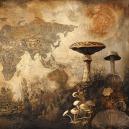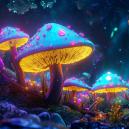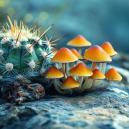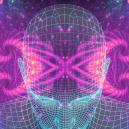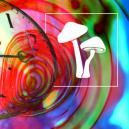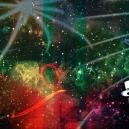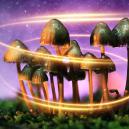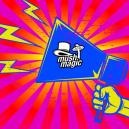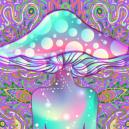Psychedelics And Psychotherapy: Hand In Hand
Published :
August 21st, 2017
Categories :
Research

Less prohibited, demystified and clinically trialled, psychedelics are becoming less about counterculture and more about profound medical breakthroughs. What were once illegal and feared may soon be prescribed and accepted universally as powerful medicines.
Psychedelics are a very broad class of compounds that primarily affect the human brain. From the Greek root words psyche (mind) and delos (manifesting), humans have had a long and rich relationship with mind-manifesting substances.
The contemporary negative view toward "drugs" over the past few decades is an aberration. Prohibition only began in earnest as a cold war-era, knee jerk, generation gap reaction to demands for social change. Prohibition was social engineering at its most malevolent.
Prior to the Schedule One classification of psychedelics and other drugs in the Western world, they were enjoyed without questioning by many of the world's populations. In fact, archaeological and historical findings suggest a coevolutionary relationship between humans and mind-altering substances.
The Eleusinian Mysteries of ancient Greece involved an agrarian cult tripping on ergot-infected rye. This predates Timothy Leary by three thousand years. Golden bongs for cannabis have been found in the graves of royalty from the steppes of Russia. Magic mushrooms appear in Christian iconography. Recent European history boasts The Great Binge of 1870-1914, which the whole of Europe and most of the remaining world was keen to get off its head. Morphine, absinthe, cocaine, opium, heroin, magic mushrooms, yohimbine and a cornucopia of brain reeling delights were all readily available. There was no social stigma.
History seems to suggest that humans like to do things to their brains. More recently, this was catalyzed by the explosion of LSD after it was let loose from Berkeley circa 1962. MDMA fuelling the late Mancunian Beat and early Rave scene. The rise and rise of homegrown cannabis, magic mushrooms, psychedelic cactus and other entheogen-containing plants. Head shops overflowing with ways to get high. All attest to the fact that humans seek altered states of mind.
These substances must be revered for a reason. They would not have become ingrained parts of many cultures if they did not have value. Modern psychotherapy is rediscovering the mental health value of a number of psychedelic compounds. Clinical trials are discovering something that the ancients knew all along. Tripping can be good for you.
LSD
LSD was synthesised by the now hallowed Albert Hofmann while working for Sandoz in 1938. Originally, he was searching for a pulmonary stimulant. The origin story is now a thing of legend and is celebrated around the world on the annual Bicycle Day. Hofmann called LSD "medicine for the soul" and was frustrated by prohibition. He felt that many people had suffered over the decades from unnecessary mental trauma caused by conditions that could be easily treated with LSD.
Prior to prohibition, LSD and other psychedelics such as psilocybin were hailed as unprecedented agents in understanding the brain. During the "golden age" of psychotherapy, thousands of papers were written about the effects of psychedelics on over 40,000 test subjects. In clinical tests between 1950 and 1965, LSD proved to be effective in the treatment of depression, addiction, anxiety, battle fatigue (later to become PTSD) and emotional and physical traumas.
Today, there is a resurgence of interest in the role that psychedelics can play in psychotherapy. A recent clinical trial that used cutting-edge brain scanning techniques suggests that LSD is a powerful medicine. Insights were observed regarding the way the brain functions and how it changes during a trip. The brains of the trial’s participants were affected in regions from which depression and anxiety are known to emanate. Prof. David Nutt declared, "These drugs offer the greatest opportunity we have in mental health. There is little else on the horizon."
It is not just in the clinic that LSD is seeing a comeback. Extreme sports athletes microdose to calm anxiety and to improve reflexes and visual acuity. Silicon Valley impresarios are microdosing as a creative and visual aid, tripping to discover the next big thing. Dr. Hofmann himself microdosed well into his old age and was convinced that LSD, when used responsibly, was a powerful tool for positive social change.
PSILOCYBIN
Psilocybin is the active compound in most magic mushrooms. There are hundreds of species of magic mushroom currently identified. They have been used by a number of cultures over the millennia for shamanistic rituals and in the current day for modern psychotherapy practices. Our friend Albert Hofmann of LSD fame was also the first chap to synthesise and name psilocybin and psilocin.
The Harvard Psilocybin Project was inaugurated by Dr. Timothy Leary and Richard Alpert in 1960 to study the effects of psilocybin. The project began as a serious, conscientious and mature attempt to raise awareness about entheogens. By 1962, the rising stars Alpert and Leary were fired over their enthusiastic promotion and distribution of psychedelics to the student body. From then on, the youth of the world started tuning in, and counterculture was born.
Fifty years later, psilocybin is enjoying a comeback, displaying promising results in clinical trials. One area of particular promise is in treating terminally ill patients experiencing overwhelming psychological distress, anxiety or depression. Traditionally prescribed medicines like Prozac and Zoloft need to be taken daily and come with unwanted side-effects. A single dose of psilocybin in a clinical setting banished end of life crises and improved psychological, spiritual and existential well-being for tests subjects. Each reported an immediate and sustained positive mood.
MDMA
The “second summer of love” in '89 saw 24-hour party people outsmarting the police to promote massive raves. Farmers would wake in the middle of the night to find a spaceship had landed in their barley field, pumping music to dilated-pupil youths in huge pants dancing their brains out and shouting "I love you man!" By the time the Shamen were cheekily thrusting "E's are good, he's Ebeneezer Goode" into the top ten, the dark side of Molly and suicide Tuesdays had panicked nations. Ecstasy, pingers, disco biscuits or Molly, were firmly placed on the Schedule One list. The neurotoxic cloud however, does have a silver lining.
MDMA was first synthesised by Merck in 1912. They were looking for a vaso-constrictor, which is a substance that controls abnormal bleeding. It made a brief appearance during the fifties when black-op military research used it for brainwashing experiments. It was also known as "the love drug" during the hippie counterculture of the sixties. Then, Molly remained obscure until 1976 when the chemist Alexander Shulgin tested incremental doses on himself. After a dose of 120mg, Dr. Shulgin wrote in his notebook,
"I feel absolutely clean inside and there is nothing but euphoria. I have never felt so great or believe this to be possible. The cleanliness, clarity and marvelous feeling of solid inner strength continued throughout the rest of the day and evening. I am overcome by the profundity of the experience."
Like other psychedelics, MDMA is receiving serious attention as a psycho-therapeutic aid. A 2008 study showed that after only a few treatments with MDMA, 83% of subjects no longer met the classification for persistent PTSD. Unlike other medicines which need to be administered daily, sometimes for life, MDMA therapy only lasts a short amount of time and is considered permanent.
CANNABINOIDS
Cannabis has evolved alongside human beings for many thousands of years. The root words for marijuana are buried deep in the etymology of a number of languages. Cloth, medicine, food or silage, the cannabis plant has proven indispensable to many cultures. You weren't really a hippie in the sixties if you didn't smoke weed and you weren't a wayfaring Raleigh without hemp sails and hemp resin chinked shipboards.
Albeit more gentle than the other psychedelics, cannabis still engenders states of mind that question the status quo. It is not surprising then that cannabis was caught in the sweeping prohibitions introduced in the mid to late-twentieth century. Not because it was proven to be dangerous to people. As with the other psychedelics, cannabis was made illegal because of what it represented culturally. Also, it directly threatened the nascent plastics, oil, paper and pharmaceutical oligarchies.
With the lifting of prohibition in a number of countries, there is an expanding body of research on the positive effects of cannabis. Several of its extractions, not all of them psychoactive, can be used for effective health care. THC is the predominant psychoactive cannabinoid in cannabis. A host of other cannabinoids, including CBD, then mediate the psychoactivity of THC. Anxiety, depression, sleep, and eating disorders are being treated effectively. As the knowledge base grows, specific strains and consumption methods will be prescribed as confidently as standard medicines today.





